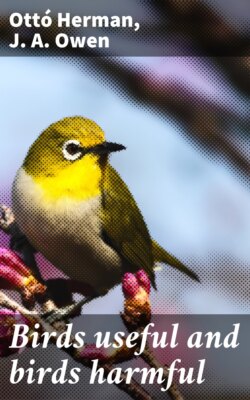Читать книгу Birds useful and birds harmful - J. A. Owen - Страница 11
На сайте Литреса книга снята с продажи.
The Short-eared Owl.
(Asio accipitrinus.)
ОглавлениеTable of Contents
In Hungary Short-eared Owls appear in numbers with the Buzzards where field mice get the upper hand, and work with these grander birds. A peculiarity of the species is to crouch down to the earth like a hen when in danger. So confiding in nature is it that it falls an easy prey to the guns of those whom we call the “Sunday sportsmen,” to the great loss of the agriculturist. Large numbers of the Short-eared Owl arrive regularly in Great Britain from the Continent, to remain with us during the winter. This species is often termed the Woodcock Owl here, partly on account of its twisting flight it is supposed, and also because both birds make their appearance about the same time—some years in larger, some years in lesser numbers. A few pairs still breed in the eastern counties, but it nests more often in the north, in widely scattered parts of our moorland districts. In Scotland the species is common; but in Ireland it has not yet been recorded as breeding, although it is very common there in winter. I remember a relative telling me of a Short-eared Owl hovering much over a terrier he had out walking with him, one evening late, on Congleton Edge. Probably the bird had its young on some tuft of heather near them and was anxious as to the safety of these, and it would not have hesitated to attack the terrier had it been alone.
Mr. Ogilvie-Grant, in Lyddeker’s “R. Natural History,” says: “It is a curious circumstance that, although the number of eggs laid by this bird (the Short-eared Owl) is generally four, yet, when food is unusually abundant, as during a lemming-migration, the number in a clutch will rise to seven or eight, and during the recent vole plague in Scotland larger numbers were recorded, reaching as many as thirteen.”
As many as ten and twelve eggs were often found on some hill farms where these Owls remained feeding all the winter and commenced nesting in March, the birds in many cases nearing a second brood.
Mr. Colles, of Higher Broughton, Manchester, speaking of the Short-eared Owl, said in a letter to his friend (R. Bosworth Smith): “You will remember that a few years ago certain parts of the country (Scotland) were infested with voles to such an extent that the sheep would not eat grass over thousands of acres of moorland. It was some two years after they had been at their worst that my son and I were fishing in St. Mary’s Loch; and one day, about noon, while I was crouching down between the high banks of the Meggett, to keep out of sight of the fish, a Short-eared Owl skimmed over the top of the bank directly to the place where I was; and I can assure you that no exaggerated comic picture of an Owl I had ever seen affected me as did this one. Its eyes looked to me as large as saucers, and the bird seemed a perfect ogre. A few days later we were fishing one of the tributaries of the Tweed near its source, and had to walk a mile or so, on almost flat moorland, where there was hardly a bush, much less a tree, to be seen. Wherever there was rise enough in the ground to form a little bank the soil was perfectly honeycombed with what appeared miniature colonnades or rather cloisters, and we caught frequent glimpses of the voles within, as they flitted along their galleries. When we were well into this dreary place a couple of Short-eared Owls positively mobbed us, and as we walked along, with our fishing-rods over our shoulders they followed us till we reached a dry gully, where they became even more demonstrative, coming well within point of our rods. On both occasions the hour was between eleven and twelve o’clock and the sun was shining brilliantly.”
The Short-eared Owl is fierce and bold in defence of her young. She will attack larger animals than herself. In the Hawaiian Islands she has always been much admired because of her fine qualities, and was indeed one of the old tutelary deities of the natives.
This Owl is from 14 to 15 inches in length. The ear-feathers are short, the irides yellow, bill black, black about the eyes, and the facial disk is browner than in the last-named species; the plumage of the upper parts is more blotched than streaked; the buff tint is more decided. The ear-tufts, though erectile, are short, and not seen except when the bird is excited. Under-parts streaked lengthwise with blackish-brown, but have no transverse bars. The young are browner and darker and more boldly marked, and tawny on the under parts, iris paler than in the adult.
USEFUL.
THE LITTLE OWL.
